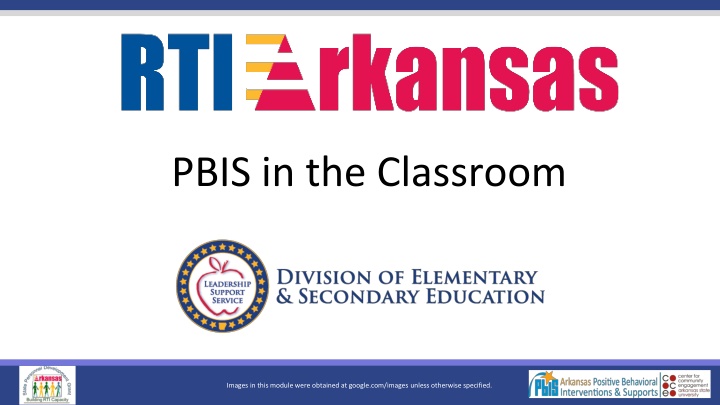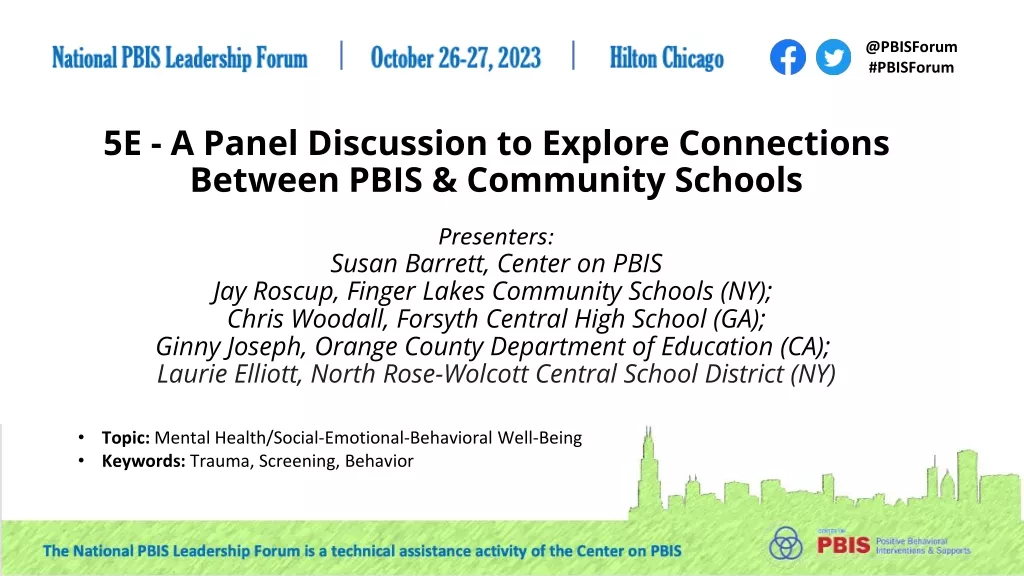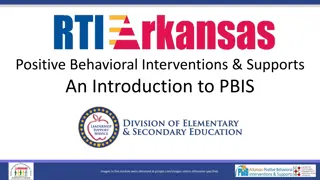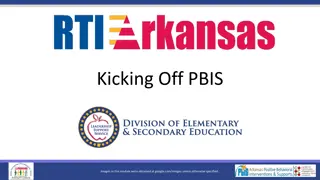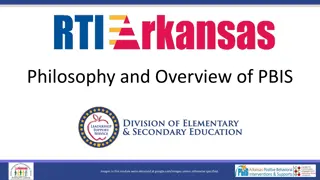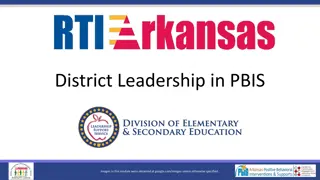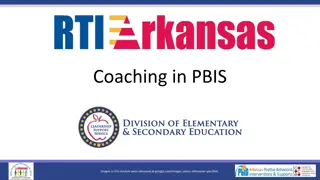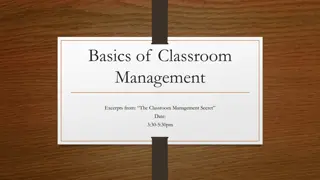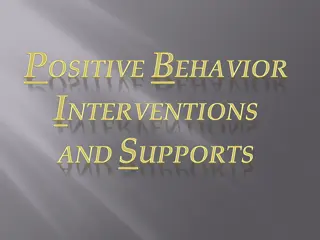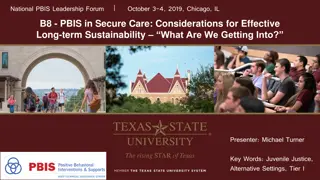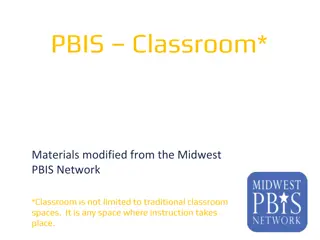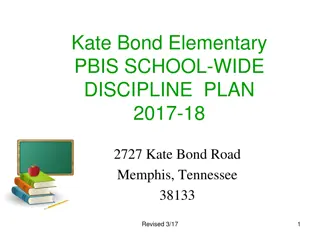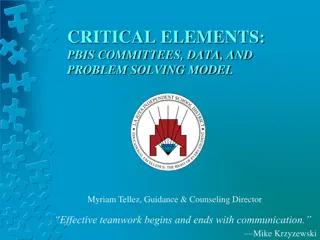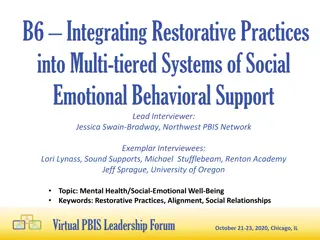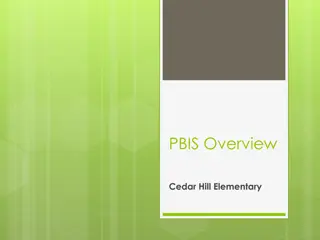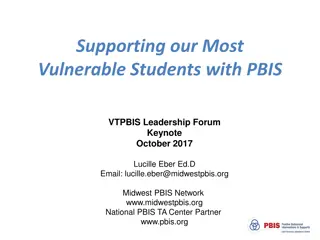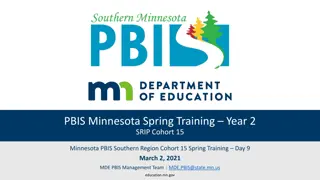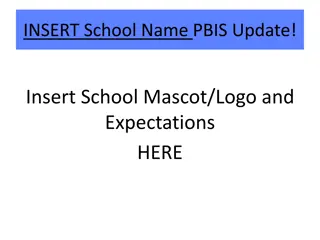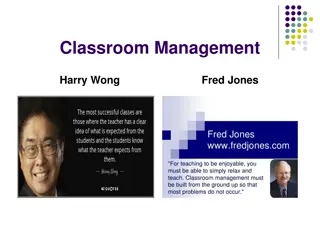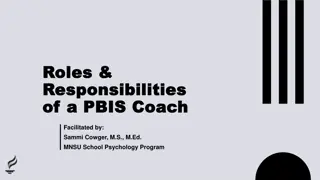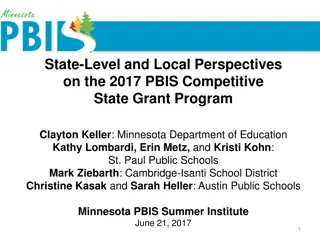Classroom PBIS Practices for Enhanced Student Engagement
Effective classroom management strategies centered around Positive Behavioral Interventions and Supports (PBIS) to create a conducive environment for student growth. Learn about establishing clear expectations, routines, and rules, encouraging positive behavior, and reducing task difficulty to increase instructional time and boost student engagement.
Download Presentation

Please find below an Image/Link to download the presentation.
The content on the website is provided AS IS for your information and personal use only. It may not be sold, licensed, or shared on other websites without obtaining consent from the author.If you encounter any issues during the download, it is possible that the publisher has removed the file from their server.
You are allowed to download the files provided on this website for personal or commercial use, subject to the condition that they are used lawfully. All files are the property of their respective owners.
The content on the website is provided AS IS for your information and personal use only. It may not be sold, licensed, or shared on other websites without obtaining consent from the author.
E N D
Presentation Transcript
PBIS in the Classroom Images in this module were obtained at google.com/images unless otherwise specified.
Outcomes Classroom PBIS practices Classroom PBIS practices that increase instructional time Classroom PBIS practices that increase engagement time Classroom PBIS data collection
Point To Ponder The goal of effective classroom management is not creating perfect children, but providing the perfect environment for enhancing their growth (Sprick, Knight, Reinke, McKale, 2006)
Discussion Discuss the impact of schoolwide expectations on student behavior in your school. Discuss the benefits of adapting school-wide expectations for the classroom.
Typical School Day 17% Direct instruction 33% Seatwork 20% Transitions 30% Discipline and other non-instructional activities (Cotton,1995;Walberg,1988)
Starting Point For Classroom PBIS Practices Create environments to increase instructional time. Create environments that increase student engagement.
Classroom PBIS Practices 1. Clear expectations 2. Procedures, routines, and rules 3. Encouraging expected behavior 4. Discouraging inappropriate behavior 5. Providing opportunities to respond 6. Active supervision 7. Changing sequence and offering choice 8. Reducing task difficulty Increase Instructional Time Increase Student Engagement
Post, define, and teach three to five positive classroom expectations. Develop and teach predictable classroom routines. Effectively design the physical environment of the classroom. The foundations of effective classroom PBIS in practice
Expectations Define three to five positive behavioral expectations. Post expectations. Teach expectations. Provide practice and feedback.
Expectations & Situations Materials I will have with me everyday: My planner My pencil & pen My notebook My textbook Ready If I forget a required item, I will borrow from a classmate or inform my teacher immediately. Responsible I will put things back where they belong. I will take care of everyone s materials. Respectful
Expectations & Situations Individual Work Time Ready I will get what I need and begin working immediately. I will always put forth my best effort. I will ask for help when needed. I will use my time wisely. Responsible I will allow others to work. I will work at my own pace. I will take pride in my work. I will do my work neatly. Respectful
Expectations & Situations Work Turn-In I will put my first name, last name, and class period on everything I turn in. Ready Responsible I will turn in late work with a late sheet properly filled out. Respectful I will neatly turn in work to the correct bin.
Routines Establish predictable routines. Teach routines and procedures. Promote self-management. Identify problematic areas or times.
Classroom Procedures & Routines Self-Assessment What is your attention signal? When do you use it? What is the procedure/routine for entering/exiting the classroom? What is the procedure/routine for personal belongings (e.g. hats, coats)? What is the procedure/routine for obtaining materials/supplies? What is the procedure/routine for the start of class? What is the procedure/routine to gain assistance?
Elementary Proactive Predictable Environment Elementary During the lesson I will Sit in a learning position. Raise my hand for a turn to talk, if I have a question, or if I need help. Wait for the teacher to come to me. Finish all of my work. Read my book if I finish my work early. Take restroom or water breaks during independent time.
Secondary Proactive Predictable Environment Secondary During the lesson I will Prepare for discussion by reading the required assignments in advance. Wait until the other person is finished speaking before I speak. Stay on topic. Respect others opinions and contributions. Use appropriate expressions of disagreement.
Design Optimize classroom layout. Minimize distraction and crowding. Post appropriate materials.
Classroom PBIS Practices that Increase Engagement Time
Acknowledge expected behavior with specific praise and other strategies. Provide high rates of varied opportunities to respond. Use prompts and active supervision. Positive classroom PBIS practices implemented consistently
Opportunities To Respond (OTR) Nonverbal responses Signal Response cards Verbal responses Individual Choral responding Think-pair-share
OTR - Individual As questions are posed, a student s name is drawn from The seating chart Strips of paper Popsicle sticks An app
OTR- Choral Responding Students read a morning message out loud together. Students recite letter sounds together. Students respond using an electronic device.
OTR- Nonverbal Responses Thumbs up if you agree with the character s choice in our story. Students respond using an electronic device.
Prompts Preventative Understandable Observable Specific and explicit
Prompt Examples Before students begin seatwork, provide a reminder about how to access help and materials. Point to a sign on the board to indicate expectations of a silent noise level prior to beginning independent work time. Review group activity participation rubric prior to the start of group work.
Active Supervision Scanning Moving Interacting
Specific Praise Individual or group Immediate Meaningful, understandable, and sincere 5:1 praise to correction ratio
Specific Praise Example When a student has not started working within one minute, say, Jason, please begin your writing assignment. Later on, say, Nice job being responsible, Jason, you have begun your assignment.
Other Strategies Changing sequences Offering choice Reducing task difficulty
Behavior Data Collection Examples Counting behaviors Timing Sampling Antecedent-behavior-consequence (ABC)
Responding To Behavior Make it FAST! Functional Accurate Specific Timely
FAST Example After a student plays with lab equipment inappropriately, the teacher responds, Please stop playing with lab equipment and keep it on the table. Later, say, Thank you for being safe with the lab equipment.
Types Of Behavior Appropriate or expected Infrequent and non-disruptive minor behaviors Repeated and non-disruptive behavior Repeated and disruptive behavior Administrator-managed behaviors
Do It With Fidelity! Tiered Fidelity Inventory (TFI) Efficient, valid index of extent to which PBIS core features are in place Section 1.8 Classroom Procedures
Summary Of Classroom PBIS Increase instructional time Increase engagement time Collect data Make it FAST!
Essential Primers & Resources For Classroom PBIS Lewis, T. Preventing and responding to problem behavior through school-wide systems of positive behavior support. Simonsen, B., Fairbanks, S., Briesch, A., Myers, D., Sugai, G. (2008). Supporting and responding to behavior evidence based classroom strategies for teachers. Weaver, J. Eight effective classroom practices. Missouri Environmental Education Association. Web link for greater depth: http://www.midwestpbis.org/materials/classroom-practices
Links To Resources Supporting and Responding to Behavior https://www.pbis.org/common/cms/files/pbisresources/Supporting%2 0and%20Responding%20to%20Behavior.pdf Preventing and Responding to Problem Behavior through School-Wide Systems of Positive Behavior Supports https://ucy.ac.cy/cypbis/documents/Sinedrio/Lewis_SW-PBS_PI.ppt Eight Effective Classroom Practices https://www.meea.org/assets/pdfs/8-effective-classroom- practices.pdf
Resources & Thanks To Simonsen, B., Fairbanks, S., Briesch, A., Myers, D., Sugai, G. (2008). Evidence-based practices in classroom management: considerations for research to practice. Education and Treatment of Children, 31(3), 351-380. https://www.pbis.org/Common/Cms/files/pbisresources/Classroom%2 0PBIS%20LEA%20SCTG%202017(Simonsen).pdf
